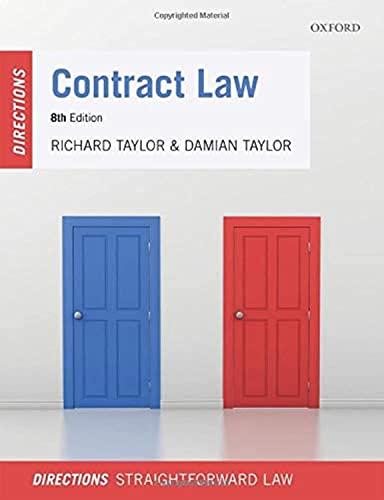Question
Please be thorough and brief with your answers and no copy and paste sentences or paragraphs from other sources ( and please no copy and
Please be thorough and brief with your answers and no copy and paste sentences or paragraphs from other sources ( and please no copy and paste excerpts from other sources), please. Please simplify as much as you can (in other words it is understandable).
Contracts:
- What are the five elements of a contract? (Note - it's only 5 if you count "offer" and "acceptance" as one element under "consensus".)
- What is an offer?What is an invitation to treat? Explain and understand the differences between them.
- What ends an offer? (lapse, revocation, rejection, counteroffer, death/insanity of offeror)
- What is revocation? When can an offer be revoked?
- What is acceptance? What is required in order for an offer to be properly accepted?
- What is consideration? What is a gratuitous promise?
- What promises can be enforceable without the legal element of consideration?
- What is capacity? What kinds of people might have an issue with capacity? What is the result of a contract formed where there is problem with capacity?
- Explain the general legal rules of intention to contract. (What is the presumption when dealing with family? What is the presumption when dealing in business?)
- What is the difference between express terms in a contract and implied terms of the contract?
- Explain how a "limitation of liability" clause works.
- Explain the difference between "void" contracts and "voidable" contracts.
- What factors would contribute to a contract being found: void; voidable; or unenforceable?
- Explain howthe following factors affect the validity of a contract:
- Mistake:
1)unilateral,
2)common,
3)mutual
- Misrepresentation:
1)Innocent (rescission only)
2)Negligent (rescission and tort damages)
3)Fraudulent/intentional (rescission and tort damages, and likely punitive damages)
- Unequal Relationships:
1)Duress -physical or financial "gun to the head" scenario
2)Undue Influence -addresses "special relationships" such as lawyer/client; more subtle - like manipulation or guilt
3)Unconscionable Transactions
- What contracts MUST be written in order to be enforceable?
- What are the main ways a contract can be ended? (Performance, Agreement, Frustration, Breach)
- What is a condition precedent?What is a condition subsequent?
- What is a variation of a contract? What does every variation require in order to make it enforceable?
- What is privity of contract?
- What is an assignment of a contract? Rights under the contract are transferred (ie: sold) to a third party. Assignment of a right under the contract does not require permission. Assignment of an obligation under the contract requires approval of the other party.
- What is a novation? Novation is the creation of a new contract by substituting a 3rdparty for one of the original parties with the consent of all.
- What are the criteria for a contract to be terminated by frustration?
Explain the difference between a condition (major term) of a contract and a warranty (minor term) and the available remedies:
Breach of condition - parties relieved from contractual obligations; damages
Breach of warranty - performance required; damages
- How do the followingremedies for breach of contractwork?
Rescission - returning the parties to the position they were in before the contract.
Rectification - correction, by the Court, of the wording of a mistake in the contract.
Damages - see notes, above.
Liquidated Damages - amt. of damages that must be paid in the event of a breach (Usually stated in the contract);
Specific Performance
Injunction
Employment Law:
- What is the name of the legislation governing employment law in Alberta that sets out minimum entitlements for employees? What is its main function?
- What is an employee? What is an independent contractor? Why is it important to make that determination?(Tax deductions, Application of the ESC such as Statutory holidays and benefits for employees, Wrongful dismissal - relevant to employees and their rights to bring an action)
- What are the factors used to determine if a worker is an employee or an independent contractor?
- Explain the concept of vicarious liability as it relates to employment law. (Is an employer vicariously liable for an employee? What about for an Independent Contractor?
- How do employment relationships end?
- What is termination of employment for just cause? What are some of the grounds for just cause? In every case, what does an employer who wants to terminate an employee for just cause need to show?
- What factors does the court look at to determine reasonable notice?
- Explain what is meant by constructive dismissal. What are some of the factors that indicate an employee is being constructively dismissed?
- What is meant by the term "mitigation of damages?"
- Non-competition clauses: What factors will the Courts use to decide if anon-competition clauseis enforceable?
1.The geographic restrictions are reasonable
2.The time restriction is reasonable
- What are some human rights requirements that apply to employment law? What are prohibited areas and what are the prohibited grounds?
- Explain what "duty to accommodate" means, as well as "bona fide occupational requirement".
- What is "undue hardship" and how does it relate to employment law?
Step by Step Solution
There are 3 Steps involved in it
Step: 1

Get Instant Access to Expert-Tailored Solutions
See step-by-step solutions with expert insights and AI powered tools for academic success
Step: 2

Step: 3

Ace Your Homework with AI
Get the answers you need in no time with our AI-driven, step-by-step assistance
Get Started


